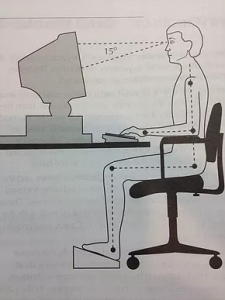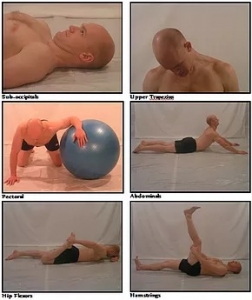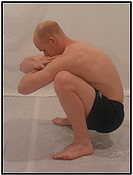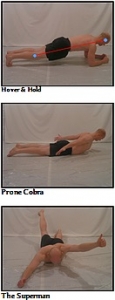July 5- Jason – Posture part 2
Desk Jockeys Guide to Better Posture Pt. 2
 I see every patient as a professional athlete. Just as an athlete invests time on a daily basis to train their body in preparation for an athletic endeavour, in the same respect, my patients every day are investing time in certain postures that can either be favourable or unfavourable to their physical condition. Through Postural Awareness we can learn to make appropriate corrections before it becomes too late. Ideally, if you’ve spent 6-hours seated each day with an improper posture then you need spend another 6-hours after work stretching and exercising to counteract the imbalance. Not going to happen, right! So, a much simpler solution is to combine your 6-hours of sitting with a distinct attention to what is more ideal, this way you gain 6-hours each day of re-educating your body to have a more optimal alignment. Plus, when you actively engage your muscles to align your body you increase your metabolic rate and calorie burning. Added bonus!
I see every patient as a professional athlete. Just as an athlete invests time on a daily basis to train their body in preparation for an athletic endeavour, in the same respect, my patients every day are investing time in certain postures that can either be favourable or unfavourable to their physical condition. Through Postural Awareness we can learn to make appropriate corrections before it becomes too late. Ideally, if you’ve spent 6-hours seated each day with an improper posture then you need spend another 6-hours after work stretching and exercising to counteract the imbalance. Not going to happen, right! So, a much simpler solution is to combine your 6-hours of sitting with a distinct attention to what is more ideal, this way you gain 6-hours each day of re-educating your body to have a more optimal alignment. Plus, when you actively engage your muscles to align your body you increase your metabolic rate and calorie burning. Added bonus!
2. One-to-three minute focused stretching
 If I’m going to be sat researching for an hour or longer, I build into my schedule a series of stretches that I can dedicate a maximum of 3-minutes. I would recommend to do this every 1-hour. The more frequent you can be, the greater the outcome for correcting your posture. Essentially, you need to stretch the short-tight muscles only. For example, recalling from our anatomy lesson from Part 1 of this article, the rhomboids and related spino-scapular muscles are muscles that do not need to be stretched. The primary muscles to stretch include the sub-occipitals, upper trapezius, pectoral, abdominals, hip flexors and hamstrings/calf. Try these stretches illustrated. All of these stretches can easily be modified and performed whilst standing.
If I’m going to be sat researching for an hour or longer, I build into my schedule a series of stretches that I can dedicate a maximum of 3-minutes. I would recommend to do this every 1-hour. The more frequent you can be, the greater the outcome for correcting your posture. Essentially, you need to stretch the short-tight muscles only. For example, recalling from our anatomy lesson from Part 1 of this article, the rhomboids and related spino-scapular muscles are muscles that do not need to be stretched. The primary muscles to stretch include the sub-occipitals, upper trapezius, pectoral, abdominals, hip flexors and hamstrings/calf. Try these stretches illustrated. All of these stretches can easily be modified and performed whilst standing.Set a timer on your computer or phone for 30-minutes and take a 1-minute movement break. If you have chance to simply take a bathroom break, walk a corridor or even perform the breathing squat exercise for 20-30 reps – this is a step forward from being permanently seated for a prolonged period of time.
 The breathing squat is one of my favourite movement patterns. It will stimulate movement, blood flow, stretch the muscles and joints and internally massage your organs aiding in digestion and elimination. Exhale as you descend into the squat, inhale as you stand upright. Move comfortably toward as full a depth as you can, avoiding any pain.
The breathing squat is one of my favourite movement patterns. It will stimulate movement, blood flow, stretch the muscles and joints and internally massage your organs aiding in digestion and elimination. Exhale as you descend into the squat, inhale as you stand upright. Move comfortably toward as full a depth as you can, avoiding any pain.
Two important notes: 1. This should not be performed if you have a recent surgery (spine or lower extremity), disc herniation or severe scoliosis. 2. Very important that your clothing permits you to complete the full range of movement!
4. Taking dedicated time (20-minutes) every 3-days to strengthen the muscles that become lengthened and weakened due to a seated posture.
 This is a very important step to see a correction in your posture. Massage is very soothing and effective for treating chronic tension. Chiropractic is very effective for realigning your spine and related joints. Stretching is effective for short-tight muscles. Meditation is great for alleviating mental emotions such as frustration and anxiety. Ultimately though, you must invest dedicated time to strengthening the longer-weak muscles. To do this, the target muscles include the cervical (neck) extensors, rhomboids, middle/lower trapezius, deep spinal stabilizers and core muscles. Primarily, the focus should be on patterns that are either held for 10-secs+ or moving for 15+ repetitions. The column of exercises to the left are examples of corrective exercises for helping to restore a more optimal alignment. Performing the Hover with a neutral position (notice the red line that shows an alignment of the ear-to shoulder-to hip) will target shoulder stability, cervical, core and postural strength. This can be done with your knees on the floor or lifted. To advance this movement you can perform with your feet on a Swiss ball and hands on the floor. Go for time on this one – maximum 3-minute hold. The Prone Cobra will target the spino-scapular and lower back muscles. The target on this is to accumulate a total time under tension of 3-minutes. An example would be 18-repetitions of 10-second holds, equaling 180-secs. You can then vary the reps and holds to work toward an end-goal of 1 rep of 3-minutes. The Superman, performed by alternating the arms and legs, can be a high rep (25 per side) exercise or similar to the Prone Cobra, you can work toward less reps and longer holds.
This is a very important step to see a correction in your posture. Massage is very soothing and effective for treating chronic tension. Chiropractic is very effective for realigning your spine and related joints. Stretching is effective for short-tight muscles. Meditation is great for alleviating mental emotions such as frustration and anxiety. Ultimately though, you must invest dedicated time to strengthening the longer-weak muscles. To do this, the target muscles include the cervical (neck) extensors, rhomboids, middle/lower trapezius, deep spinal stabilizers and core muscles. Primarily, the focus should be on patterns that are either held for 10-secs+ or moving for 15+ repetitions. The column of exercises to the left are examples of corrective exercises for helping to restore a more optimal alignment. Performing the Hover with a neutral position (notice the red line that shows an alignment of the ear-to shoulder-to hip) will target shoulder stability, cervical, core and postural strength. This can be done with your knees on the floor or lifted. To advance this movement you can perform with your feet on a Swiss ball and hands on the floor. Go for time on this one – maximum 3-minute hold. The Prone Cobra will target the spino-scapular and lower back muscles. The target on this is to accumulate a total time under tension of 3-minutes. An example would be 18-repetitions of 10-second holds, equaling 180-secs. You can then vary the reps and holds to work toward an end-goal of 1 rep of 3-minutes. The Superman, performed by alternating the arms and legs, can be a high rep (25 per side) exercise or similar to the Prone Cobra, you can work toward less reps and longer holds.
I always recommend if you are unsure about how to effectively perform any recommended stretch or exercise then seek out advice from either myself or a qualified exercise specialist. If you have any pre-existing health conditions, seek your physician’s advice. Remember, even with these exercises, if you have a recent surgery, disc herniation or severe scoliosis seek further medical advice prior to beginning this program.
Yours In Muscle Health,
Natural High Fitness is located at
the Okotoks Recreation Centre.
99 Okotoks Drive
Okotoks, Alberta
403-938-4483
The Natural High Crossfit Box is located at:
113 Fisher Street
Okotoks, Alberta
403-938-7051 CrossFit Classes
403-828-3512 CrossFit Kids Classes
Mailing address:
PO Box 1545
Okotoks, AB
T1S 1B5
—– Fitness Centre —–
Natural High Fitness Social
—– Crossfit Box —–
Natural High Cross Fit Social
